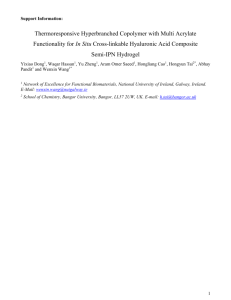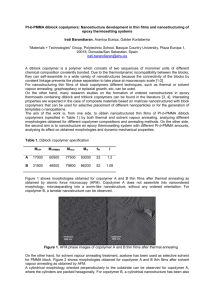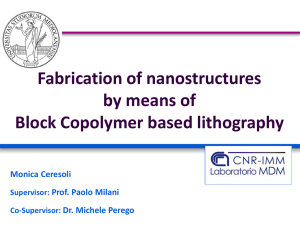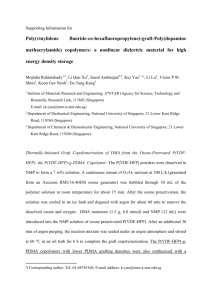ACTES copolymers
advertisement
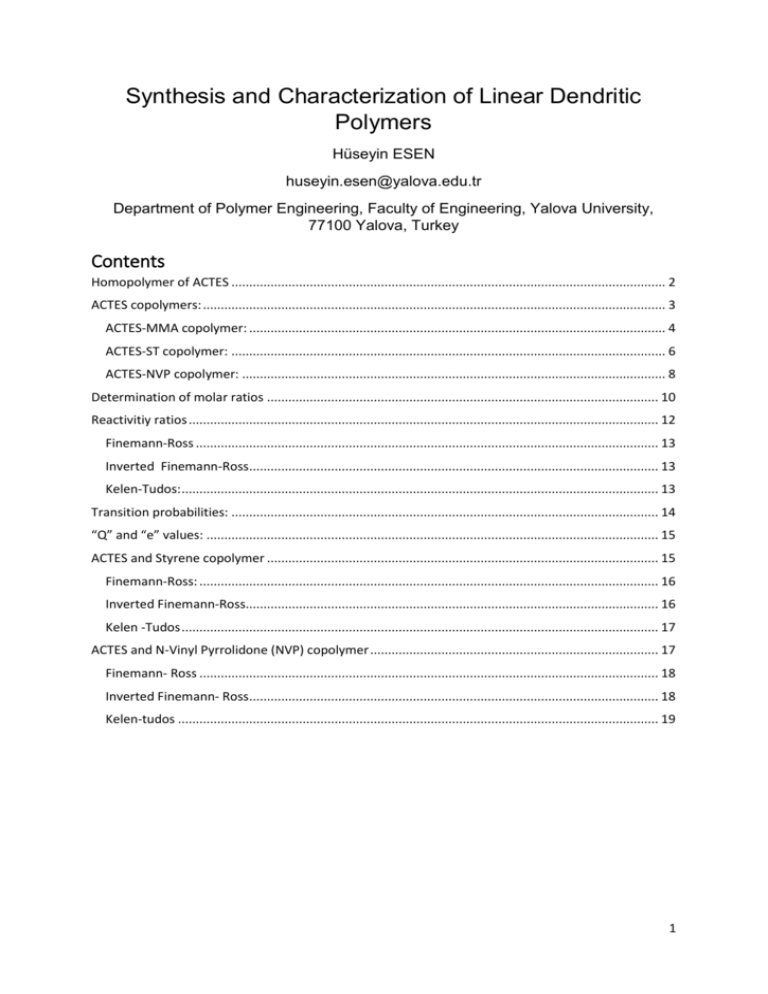
Synthesis and Characterization of Linear Dendritic Polymers Hüseyin ESEN huseyin.esen@yalova.edu.tr Department of Polymer Engineering, Faculty of Engineering, Yalova University, 77100 Yalova, Turkey Contents Homopolymer of ACTES .......................................................................................................................... 2 ACTES copolymers: .................................................................................................................................. 3 ACTES-MMA copolymer: ..................................................................................................................... 4 ACTES-ST copolymer: .......................................................................................................................... 6 ACTES-NVP copolymer: ....................................................................................................................... 8 Determination of molar ratios .............................................................................................................. 10 Reactivitiy ratios .................................................................................................................................... 12 Finemann-Ross .................................................................................................................................. 13 Inverted Finemann-Ross ................................................................................................................... 13 Kelen-Tudos: ...................................................................................................................................... 13 Transition probabilities: ........................................................................................................................ 14 “Q” and “e” values: ............................................................................................................................... 15 ACTES and Styrene copolymer .............................................................................................................. 15 Finemann-Ross: ................................................................................................................................. 16 Inverted Finemann-Ross.................................................................................................................... 16 Kelen -Tudos ...................................................................................................................................... 17 ACTES and N-Vinyl Pyrrolidone (NVP) copolymer ................................................................................. 17 Finemann- Ross ................................................................................................................................. 18 Inverted Finemann- Ross ................................................................................................................... 18 Kelen-tudos ....................................................................................................................................... 19 1 Homopolymer of ACTES ACTES (1.67 g, 4.77 mmol) was replaced in a schlenk tube and dioxane (4.77 ml) was added as polymerization solvent just enough to obtain the concentration as 1M. Benzoyl peroxide (11.5 mg) was added as 1 mol % of the ACTES. The solution was purged with nitrogen for 30 minutes. Tube was sealed, heated to 80 C and mixed for 24 hours. Polymerization mixture was then precipitated into methanol after 24 hours, filtered and dried (yield 73 %). Proton, carbon NMR and GPC graph are shown in Figure1, Figure 2 and Figure 3. p-aktes-aseton.010.esp 0.45 0.40 Normalized Intensity 0.35 0.30 0.25 0.20 0.15 0.10 0.05 8.0 7.5 7.0 6.5 6.0 5.5 5.0 4.5 4.0 3.5 Chemical Shift (ppm) 3.0 2.5 2.0 1.5 1.0 0.5 0 Figure 1: Proton NMR spectrum of homopolymer of ACTES 2 0.11 p-aktes-aseton.011.esp 0.10 0.09 0.08 Normalized Intensity 0.07 0.06 0.05 0.04 0.03 0.02 0.01 0 -0.01 180 160 140 120 100 80 Chemical Shift (ppm) 60 40 20 0 Figure 2: Carbon NMR spectrum of homopolymer of ACTES Figure 3: GPC of ACTES homopolymer ACTES copolymers: General procedure for the synthesis of copolymers was as follows 0,6012 g (1,28 mmol) ACTES, selected amount of comonomer (after removal of inhibitor) and benzoyl peroxide (1 mol % of total polymerizable monomers) were placed into schlenk tube and dissolved in 8 ml dioxane. Solution was purged with nitrogen for 30 3 minutes and sealed. Mixture was heated up to 90 C in glycerol bath and mixed for overnight. Mixture was precipitated into methanol upon cooling, then filtered and dried. ACTES-MMA copolymer: Synthesis of copolymer was as follows 0,6012 g (1,28 mmol) ACTES and 0,0602 g (0,2528 mmol) benzoyl peroxide (1 mol % of total polymerizable monomers) were placed into schlenk tube and dissolved in 8 ml dioxane. 2.4 g (24 mmol) MMA (removed from inhibitor) was added and purged with nitrogen for 30 minutes and sealed. Mixture was heated up to 90 C in glycerol bath and mixed for overnight. Mixture was precipitated into methanol upon cooling, then filtered and dried (yield 84 %). FT_IR, Proton NMR spetra, GPC and DSC graphs were shown in Figure 4, Figure 5, Figure 6 and Figure 7, respectively. 100.6 95 90 2992.06 2950.43 1388.32 842.66 85 1480.61 1367.91 1066.29 986.72 964.85 750.11 80 1435.08 75 1239.48 %T 70 65 1190.01 60 55 1723.52 50 1143.55 45 42.5 4000.0 3600 3200 2800 2400 2000 1800 cm-1 1600 1400 1200 1000 800 650.0 Figure 4: FT-IR spectrum of ACTES-MMA copolymer 4 Figure 5: Proton NMR spectrum of ACTES-MMA copolymer Figure 6: GPC result of ACTES-MMA copolymer 5 Figure 7: DSC curve of ACTES-MMA copolymer ACTES-ST copolymer: Synthesis of copolymer was as follows 0,6012 g (1,28 mmol) ACTES and 0,0602 g (0,2528 mmol) benzoyl peroxide (1 mol % of total polymerizable monomers) were placed into schlenk tube and dissolved in 8 ml dioxane. 2.4 g (23.01 mmol) styrene (removed from inhibitor) was added and purged with nitrogen for 30 minutes and sealed. Mixture was heated up to 90 C in glycerol bath and mixed for overnight. Mixture was precipitated into methanol upon cooling, then filtered and dried (yield 73 %). FT_IR, Proton NMR spetra, DSC and TGA graphs were shown in Figure 8, Figure 9, Figure 10 and Figure 11, respectively. Figure 8: FT-IR spectrum of ACTES-ST copolymer 6 Figure 9: Proton NMR spectrum of ACTES-ST copolymer Figure 10: DSC graph of ACTES-ST copolymer 7 Figure 11: TGA graph of ACTES-ST copolymer ACTES-NVP copolymer: Synthesis of copolymer was as follows 0,6012 g (1,28 mmol) ACTES and 0,0602 g (0,2528 mmol) benzoyl peroxide (1 mol % of total polymerizable monomers) were placed into schlenk tube and dissolved in 8 ml dioxane. 2.4 g (21.6 mmol) NVP (removed from inhibitor) was added and purged with nitrogen for 30 minutes and sealed. Mixture was heated up to 90 C in glycerol bath and mixed for overnight. Mixture was precipitated into methanol upon cooling, then filtered and dried (yield 77 %). FT_IR, DSC and TGA graphs were shown in Figure 12, Figure 13 and Figure 14, respectively. Figure 12: FT-IR of ACTES-NVP copolymer 8 Figure 13: DSC graph of ACTES-NVP copolymer Figure :14 TGA graph of ACTES-NVP copolymer 9 Determination of molar ratios In situ NMR technique was applied to determine conversions of monomers. Polymerization mixture was prepared in NMR tube with deutero DMSO and initial spectrum was acquired at room temp. And sample was ejected. Then NMR probe was heated to 90 C and sample was inserted and NMR spectrum were collected every 15 minutes. Conversion of monomers were followed by the decrease in normalized intensities of signal coming from unsaturations. Reactions and acquisitions were halted before 10 % conversions of monomers. Conversions of styrene, N- vinyl pyrrolidone and ACTES monomers were calculated according to the equation (1) below where A0 is the initial normalized integral of the monomer peak and At is the normalized integral of the monomer peak at time t. Proton NMR spectra of the initial mixtures of ACTES-styrene and ACTES-NVP were given below in Figure 15 and Figure 16, respectively. In both spectra signal coming from unsaturations of all monomers donot coincide with each other and are suitable to follow conversions. Figure 15: Proton NMR spectra of the initial mixture of ACTES-ST 10 Figure 16: Proton NMR spectra of the initial mixture of ACTES-NVP Mole fractions of styrene and ACTES in the copolymer compositions can be determined from following equations: Mole fractions of NVP and ACTES in the copolymer compositions can be determined from following equations: 11 For the copolymerization reaction of styrene and ACTES, “f” and “F” were obtained by simplification of above equations as: For the copolymerization reaction of NVP and ACTES, “f” and “F” were obtained by simplification of above equations as: Reactivitiy ratios Reactivity ratios were determined according to the Finemann-Ross, Inverted Finemann-Ross and Kelen-Tudos methods. In all methods parameters to determine the reactivity ratios were calculated from “f”, the feed ratio and “F”, composition in the copolymer. 12 Finemann-Ross Parameters used in Finemann-Ross method to obtain reactivity ratios, “G” and “H” were obtained with following equations. Reactivity ratios of the monomers were obtained from the linear relationship below: Inverted Finemann-Ross Reactivity ratios are also obtained from inverted Finemann-Ross method with the following equation: Kelen-Tudos: The parameters for the Kelen-Tudos method were also given as: Ƞ = G / (α + H) 13 Transition probabilities: By using the reactivity ratios of styrene and ACTES it is possible to find probability p11 of forming M1M1 dyads in the copolymer at a given monomer feed Similarly, the probabilities p12, p21 and p22 for forming pairs of M1M2, M2M1 and M2M2, respectively, are given by Also number average monomer sequence lengths can be obtained by following formulas: 14 “Q” and “e” values: ACTES and Styrene copolymer Copolymer M1 M2 α = 1,327 ACT-ST1 8 2 ACT-ST2 6 4 ACT-ST3 4 6 ACT-ST4 2 8 F 4 1,5 0,67 0,25 f G H Ƞ ξ 1,644 1,568 9,732 0,142 0,880 1,096 0,131 2,053 0,039 0,607 0,809 -0,158 0,555 -0,084 0,295 0,344 -0,476 0,181 -0,316 0,120 Conversiona (%) 8,5 12 7,4 7,03 Table 1. Finemann-Ross, Inverted Finemann-Ross ve Kelen-Tudos parameters for ACTES-Stiren monomer pair. a : Conversion averages of ACTES and Styrene monomers. 15 Finemann-Ross: Figure17. “Finemann – Ross” graph for ACTES and Styrene monomer pair. Inverted Finemann-Ross Figure 18. “Inverted Finemann – Ross” graph for ACTES and Styrene monomer pair. 16 Kelen -Tudos Figure 19. “Kelen Tudos” graph for ACTES and Styrene monomer pair. ACTES and N-Vinyl Pyrrolidone (NVP) copolymer Copolymer M1 M2 F f G H Ƞ α = 1,69 ACT-VP1 8 2 4 1,776 1,748 9,011 0,163 ACT-VP2 6 4 1,5 0,901 -0,165 2,497 -0,039 ACT-VP3 4 6 0,67 0,576 -0,493 0,779 -0,200 ACT-VP4 2 8 0,25 0,197 -1,019 0,317 -0,508 ξ Conversiona (%) 0,842 0,596 0,316 0,158 9,9 7,6 5,4 3,8 Table 2. Finemann-Ross, Inverted Finemann-Ross ve Kelen-Tudos parameters for ACTES-NVP monomer pair. a : Conversion averages of ACTES and NVP monomers. 17 Finemann- Ross Figure 20. “Finemann – Ross” graph for ACTES and NVP monomer pair. Inverted Finemann- Ross Figure 21. “Inverted Finemann – Ross” graph for ACTES and NVP monomer pair. 18 Kelen-tudos Figure 22. “Kelen Tudos” graph for ACTES and NVP monomer pair. 19
